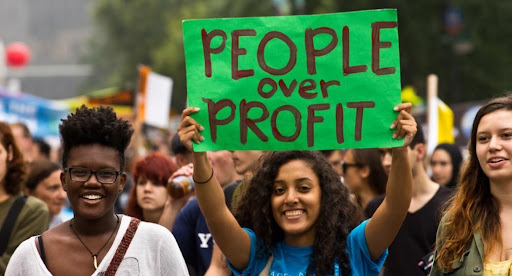- Dr Ioannis Tsipouridis, Visiting Professor at Meru University Of Science and Technology (MUST) and Technical University of Mombasa, Kenya
- Professor Romanus Odhiambo Otieno, Vice Chancellor Meru University Of Science and Technology (MUST), Meru, Kenya
In 2015, the 2030 Agenda for Sustainable Development, containing the 17 SDGs Sustainable Development Goals, was approved.
The agenda was “…an urgent call for action by all countries – developed and developing – in a global partnership. They recognize that ending poverty and other deprivations must go hand-in-hand with strategies that
- improve health and education,
- reduce inequality, and
- spur economic growth –
- all while tackling climate change and
- Working to preserve our oceans and forests.”
It has to be admitted that it was an amazing vision. One of humankind’s very rare moments of brilliance.
Who could ask for more?
It created hope that a better sustainable and just tomorrow for all was possible.
The SDGs constituted a Code for sustainable and Just living in harmony with all other species, including our own…… biodiversity and the planet, OUR HOME
So much so that captured the imagination and raised hopes of poor people that finally something was about to change.
Unfortunately they proved just another good plan, containing an excess of good intentions and plenty of hot air.
To date, 8 years later, at half point, the overall assessment, by the UN itself, of the progress of SDGs, is summarised as follows:
According to a new UN report, progress on the Sustainable Development Goals (SDGs) is not going well. Among roughly 140 assessed SDG targets, only 12% are on course to meet the 2030 deadline .
Meanwhile, 50% of the action plan has seen “weak and insufficient” progress.
Progress on nearly one third of the SDGs has either remained unchanged or even fallen below 2015 levels.
“Unless we act now, the 2030 Agenda will become an epitaph for a world that might have been,” said António Guterres, the UN secretary-general, in remarks delivered Tuesday (April 25).
The UN Secretary-General António Guterres, in NY on 26 April 2023: sounded the alarm as he briefed Member States on the report: ‘Progress towards the Sustainable Development Goals: Towards a Rescue Plan for People and Planet’.
“Halfway to the deadline for the 2030 Agenda, we are leaving more than half the world behind. We have stalled or gone into reverse on more than 30 percent of the SDGs,”
“Unless we act now, the 2030 Agenda will become an epitaph for a world that might have been”, said the Secretary-General.
According to the 2023 Financing for Sustainable Development Report, 52 low- and middle-income developing economies are either in debt distress or at high risk of debt distress, accounting for more than 40% of the world’s poorest people.
“The international financial architecture is short-sighted, crisis-prone, and bears no relation to the economic reality of today,” said UN Secretary-General António Guterres.
“The SDGs are the path to bridge both economic and geopolitical divides; to restore trust and rebuild solidarity,” added the UN Chief. “Let’s be clear: no country can afford to see them fail.”
The UN conscious of the looming failure is escalating its reaction and raising the threshold of the alarm, hoping that some will heed the call. So the sincere by all accounts UN Secretary General, is trying to mobilise “global leaders” and individuals (using influencers!!!) in order: “To close the SDG annual funding gap, which has soared from $2.5 trillion before covid to over $4 trillion last year.”
It’s doubtful that even the good UN Secretary General believes this to be possible.
Studies carried out by Universities and Think Tanks conclude that the problem (and hence the solution) lies with the system itself.
”Sustainability has never been higher on the international agenda. But an international assessment of the Sustainable Development Goals (SDGs)—the 17 global goals used by governments, companies, and NGOs worldwide to guide action towards a prosperous and just future—shows they are having limited impact, and may instead be contributing to greenwashing.
The goals are bound to fail because they exist within a world system largely unmentioned within the list of 17 goals.”
A letter signed by 100 scientists, teachers and experts from 37 countries argues that it is time for the UN to dispose of the sustainable development concept and in particular of the 17 Sustainable Development Goals (SDGs)
“.. due to 30 years of proven failure from its allegiance to global capitalism”.
It seems the world is waking up to the fact that you cannot correct the mistakes of the old world using the same tools that brought us to the edge of the climate abyss.
The following statement describes it perfectly:
“Today’s global economy was based on two pillars; the exploitation of people, and the exploitation of the planet; that were fundamentally unjust, unsustainable and incompatible with the full enjoyment of human rights.”
It’s no wonder that SDGs have failed so far.
And it’s more probable than not, that nothing will change till 2030, in spite the plethora of wishes and pledges and high level meetings.
An in fact we shouldn’t be afraid to speak out the truth and admit that the signs of impeding failure were there from the very beginning.
SDGs were born in September of 2015, but the pregnancy lasted for 23 years… as talks begun in 1992.
Similarly the recently approved during last year’s COP 27 in Egypt, Loss&Damage fund, was negotiated since 1991; 32 years!
One can suppose that it is usual and reasonable for UN negotiations to take a long time given the number of countries (196) taking part in the negotiations.
Nope. My bet is on the fact that some nations representing interest groups or succumbing to pressure by interest groups delay and derail the negotiations, playing in essence for time…..apparently successfully.
These unreasonably prolonged negotiations are an early warning sign of the real intentions of the stakeholders representing market forces.
For example, it was no surprise that recently Special Envoy John Kerry said in a congressional hearing that “under no circumstances” would the US pay climate reparations to developing countries hit by climate fueled disasters.
A few months before COP 28 opens its doors in Oil land presided by an Oil Lord while the globe is baking in 50 deg Celsius can we really expect the old system to fall back on itself?
The UN Secretary General blames the lingering effects of the COVID-19 pandemic, the climate crisis, a weak global economy, and the amplification of all problems caused by the Russian invasion of Ukraine.
Valid as the causes are, this is the world we have created from time immemorial.
These are recurring events.
Only places and names change,
It’s because of such problems that SDGs were considered absolutely necessary; hence you can’t use the reasons for their creation as the causes of their failure.
Or can you?
The problems existed and exist and some are actually worse than when this initiative began.
Failure to progress underlines the fact that you cannot solve a problem using the same method and forces that caused the problem in the first place.
To spell it out:
Exploitation of planet and people causes environmental and climate crisis and humane crisis and therefore you cannot expect to solve these issues as long as you continue to exploit the planet and the people.
You need:

A few weeks before another high-level SDG summit let’s accept that a totally new direction is urgently needed, it’s wide open in front of us and let’s walk the talk.


